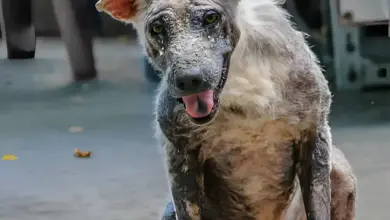
Stray dogs—animals who once may have had homes, warmth, and care—are often reduced to shadows on the streets. They wander without food for days, ignored by the world around them, suffering in silence as life passes by without so much as a second glance. These abandoned creatures live a life that is filled with hunger, fear, and uncertainty. While they may have once known love or a full belly, the reality of their current situation is stark and unforgiving. To many, they are invisible, unloved, and left to fend for themselves in a world that seems to have forgotten them.

One of the greatest challenges faced by stray dogs is the constant battle for food and water. Unlike household pets who are fed regularly, strays must rely on their instincts and luck to survive. Searching through garbage, scavenging leftovers, or relying on the kindness of strangers becomes their daily reality. However, in many cases, their efforts yield little, leaving them weak and vulnerable. Hunger gnaws at their insides, and thirst burns their throats, making survival a constant struggle. And unlike wild animals who are accustomed to fending for themselves, these dogs often come from domesticated backgrounds, which means they are ill-equipped to handle life on the streets.

The lack of food is just one aspect of their suffering. The emotional toll that comes with abandonment is perhaps even more profound. Many stray dogs once had owners, homes, and a sense of belonging. To be suddenly abandoned or lost is a traumatic experience. Dogs, being social creatures, crave companionship, love, and attention. Without it, they experience deep loneliness. Stray dogs often roam in search of human contact, hoping for a gentle touch or a kind word, but they are frequently met with indifference or, worse, hostility. People may kick them, shoo them away, or call authorities to remove them. This rejection only deepens their sense of abandonment, making their already challenging lives even harder.

Beyond the emotional suffering, stray dogs also face countless physical dangers. The streets are filled with hazards—cars, disease, aggressive animals, and sometimes even cruel humans. Traffic is a constant threat, and many stray dogs are injured or killed in accidents. Without proper veterinary care, even minor injuries can become life-threatening infections. Furthermore, diseases such as rabies and distemper spread quickly among stray populations, decimating their numbers. These illnesses, combined with malnutrition, lead to painful and often slow deaths.

The life of a stray is also one of constant fear. Every corner could hide a threat, every alley could bring a new danger. Stray dogs are often chased by other animals, harassed by humans, or caught by animal control officers. For those that end up in shelters, the situation may seem like an improvement at first, but many shelters are overcrowded and underfunded. In some places, strays are kept for only a short period before they are euthanized due to a lack of space or resources to care for them. The lucky ones may be adopted, but the majority face an uncertain and grim future.

Despite their suffering, stray dogs often show remarkable resilience and loyalty. Many still seek out human contact, hoping against hope that someone will show them kindness. Some strays form packs, finding comfort and protection in numbers. Together, they navigate the harsh streets, sharing whatever scraps they can find and offering each other companionship. These dogs, who have known both love and loss, display a level of perseverance that is both heartbreaking and inspiring. Their ability to keep going, despite the odds stacked against them, speaks to their incredible strength.

However, the plight of stray dogs is not just a tragedy—it is also a reflection of human negligence. These animals did not choose to live on the streets. Many were abandoned by their owners, victims of circumstances beyond their control. Whether due to financial hardship, moving, or simply losing interest, people often discard their pets without considering the consequences. This act of abandonment is not only cruel but also avoidable. Responsible pet ownership, including spaying and neutering, could drastically reduce the number of stray dogs on the streets. Yet, too often, these measures are not taken, and the cycle of suffering continues.

There are glimmers of hope, however, in the form of individuals and organizations dedicated to helping stray dogs. Animal shelters, rescue groups, and compassionate individuals work tirelessly to provide food, medical care, and love to these animals. In many places, there are also initiatives to spay and neuter stray dogs to control the population humanely. Volunteers often spend their time feeding and caring for stray animals, doing their best to make up for the neglect these dogs have experienced. For the lucky few, these efforts result in adoption, giving them a second chance at life. For others, the kindness of strangers may be the only love they ever know.

But these efforts, while commendable, are not enough to address the larger issue. The sheer number of stray dogs worldwide is overwhelming, and without broader societal changes, the problem will persist. It requires a collective effort—one that includes responsible pet ownership, stricter laws against abandonment, and more support for animal welfare organizations. Education is also key, as many people do not realize the impact of their actions when they abandon a pet or fail to spay and neuter. If people understood the suffering these animals endure, perhaps they would think twice before contributing to the problem.

In the end, stray dogs are a reminder of our moral responsibility as humans. We have domesticated these animals, and in doing so, we have taken on the responsibility to care for them. Yet, too often, we fail them. As they wander the streets, hungry and unloved, they are silent witnesses to our neglect. Their plight is not just an animal issue—it is a human one. And until we recognize that, they will continue to suffer.

To those who have ever passed by a stray dog without a second thought, I urge you to consider their story. Behind every stray is a tale of abandonment, pain, and longing. They are not invisible. They are not beyond help. And most importantly, they are not beyond love. With compassion, awareness, and action, we can make a difference in the lives of these animals who have been left behind, offering them the care and love they so desperately need.






